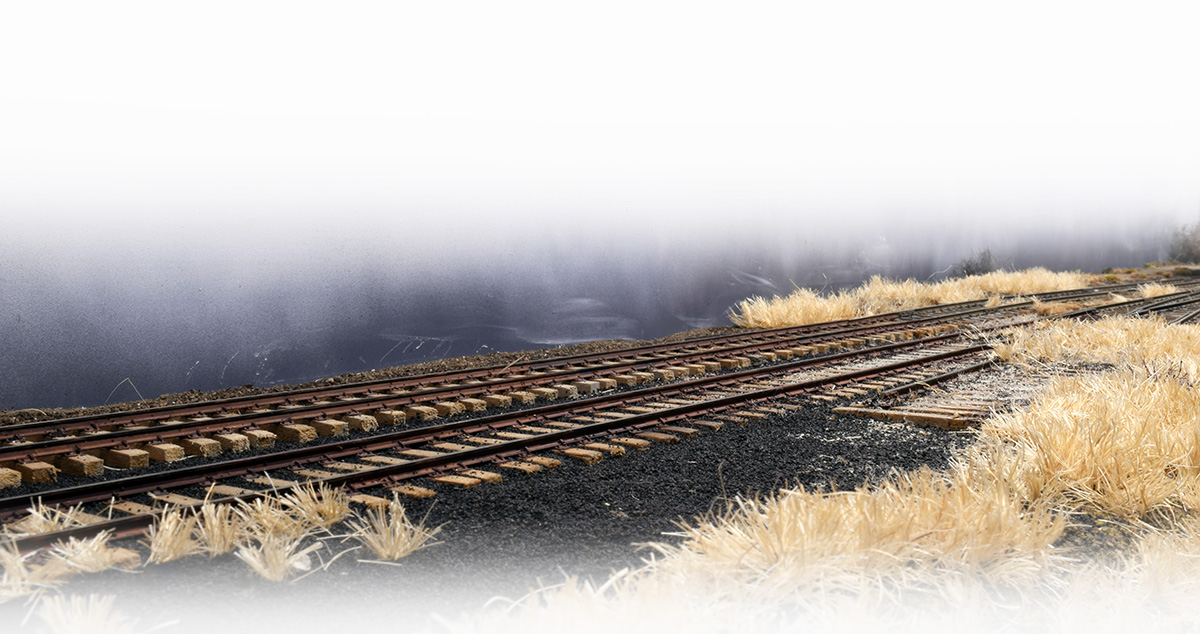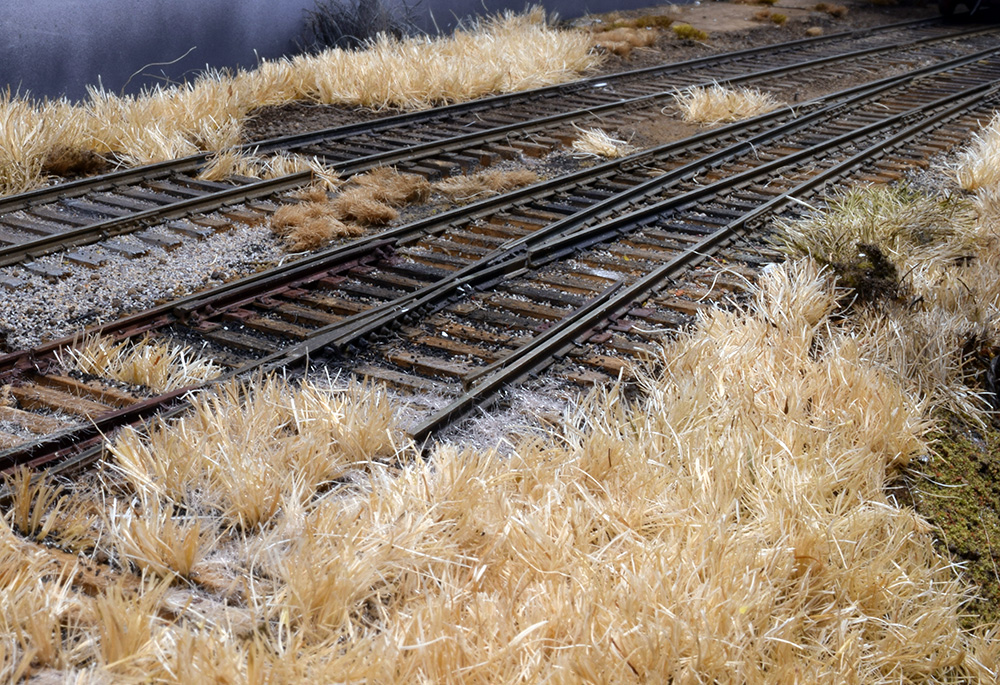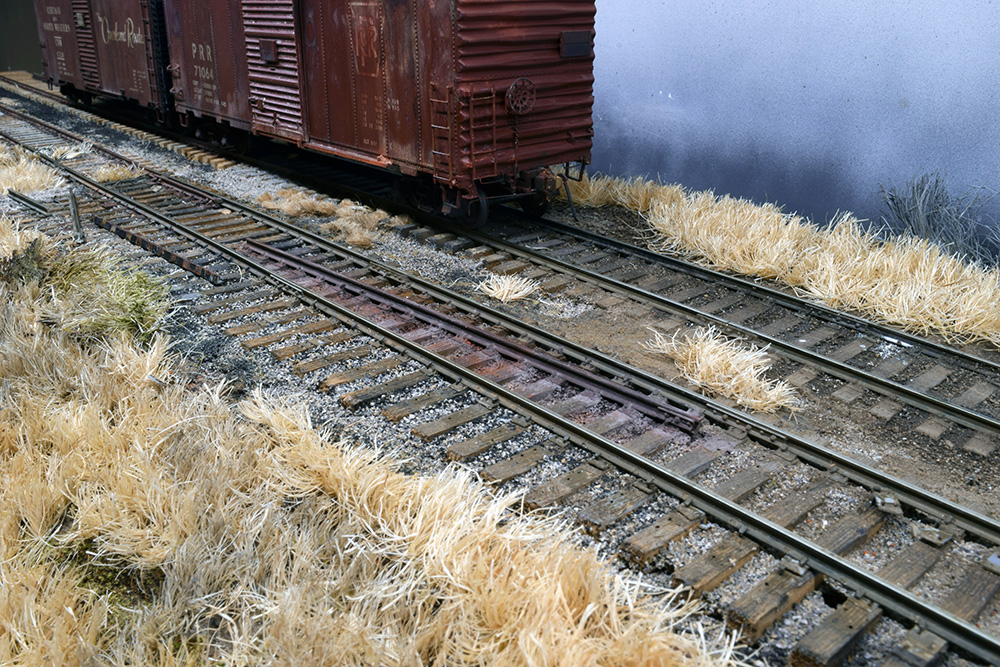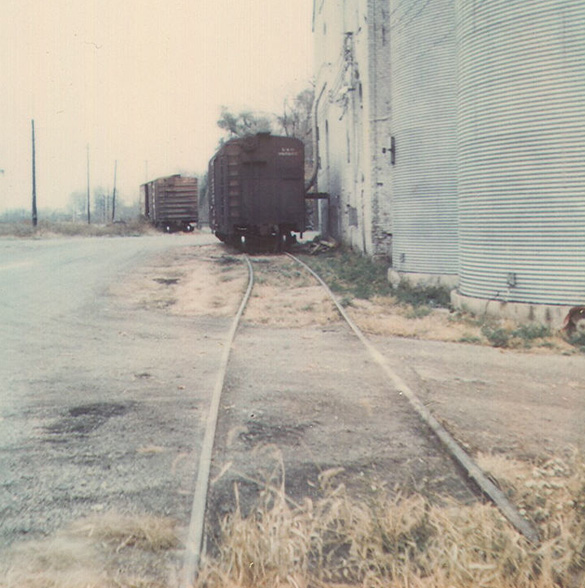
On the old layout I had three tracks on one end that crowded things from front to back. I removed two of them and the improvement and breathing room this provided was huge. I backed myself into the same situation on the Mill Road cameo, by placing three tracks on the left end. After mulling it over, I removed the one in front because I didn’t need it. As before this provided a much-needed sense of space that complements the rest of the cameo. I’ll use a bit of storytelling with a pile of old crossties and tieplates along with pieces of rail to suggest what happened here.


I’m of the opinion that we treat track as too precious and delicate. It feels like a holdover from toy trains on the floor and worrying too much about maintaining electrical contact. Naturally, each scale is different in terms of what the models will tolerate and code 125 rail is like a steel girder compared to codes 70 or 55 but, my experience with P48 suggests that you can abuse track far more than you might think and still have reliable operation. HO or N scales are a different story because the models are much lighter and points of wheel contact much smaller, so there is no universal application for every scale. It’s always a matter of trial and error.
I also think we tend to box our modeling approach according to what we’re working on. Okay, I’m laying track, so the rails are this color, the ties are brown and the ballast is gray. Now I’m doing scenery, so dirt is this bag of brown material, grass is green and on it goes. This can result in a lack of cohesive tones across the entire scene. We tend to forget that scenery weathers too. Wind blown dust and dirt particles settle over everything and will impart a more uniform tone over time. Something the diorama artists and military folk understand far better than we do.


Carrying these textures and colors across the cameo brings a cohesive look that allows the eye to move along easily, rather than jump from one texture to another.
Handlaid P48 track is robust and I’ve gone over sections with additional weathering and materials more than once. I’m not afraid to pile on material and bury track because I’ve learned how far to go before problems surface. I’ve had to go back and trim away tall grass and weeds that interfered with operation and chisel away the odd bit of excess ballast but both are simple to do. The truth is that the only thing stopping us from elevating our modeling is our own preconceptions about what’s possible and practical. As mentioned, each scale is different and detailing that works in a larger scale may not in a smaller one. However, I believe it’s time to put the toy train worries away.
Mike
I always felt that the scene around the pole track on your I&W was rather special. Maybe it was the dust from the broken slabs?
I have seen it suggested that when painting models, it is a good idea to add a “unifying tint” to each colour, to create adhesion between them. I think you have stumbled onto a similar idea here, to extend it to the scenery but also via texture. That’s a very powerful idea.
“I want viewers of Mill Road to discover there’s track in the landscape rather than think I just added a couple strips of scenery along the edges of the track.”
In a narrow shelf the track occupies so much of the area that the scenery along the perimeter can easily become something that’s just there but not connected. I know from my own experience how challenging it is to convert an only inches wide strip of land into something that is a rich looking model and not just a rough edged transition between the layout and the backdrop or fascia. My work always turned out looking like a hasty afterthought. In the real world, things coexist and changes in the environment affect each element evenly. Eventually they collectively blend into one cohesive form. Rust and oil from the track changes the land as it bleeds across it while that same earth is silently consuming the railroad.
Removing this forward siding is a brilliant design move. The evidence of its existence still contributes the identities of “siding” and “railroad” but in a style of compromise by inviting the foreground deeper into the scene. A turnout left in place, in whole, is a siding that could someday be used but as it is now it’s clear a decision has been made and a reality faced. Today, we’re standing on what’s left of that third siding and it’s hard to ignore this evidence of impermanence. (“I’d heard they spotted two cars at the elevator yesterday and I’m sure glad we took the day off to come down here and see. How long has it been since we last did this? Too long.”)
There’s an interesting perspective here too in your comment on the relationship between scale and options. The larger O scale model is closer in size to modelling the weight characteristics of the real thing. It’s less intimidated by a piece of errant ballast glued in the flangeways than something in the smaller scales would. That’s a good consideration to include when thinking about what scale to work in. One more note for the “why” of the decisions we make in this hobby if we’re trying to make better educated ones.
Your work excites my imagination so completely. Thank you for the updates on this project.
Chris
I love this…addition by subtraction. A disused siding doesn’t have much to say. A removed track with some remnants left behind is almost a conversation starter…”what was here? what purpose did it serve?”
And yes, in time, nature lays a unifying layer across everything in a scene…
Great ideas.
Mike;
One of the reasons why I’ve kept an association with the local armour and other modelling clubs over the years is the way they and figure modellers use landforms to stage their models, without isolating each other in the process.
Each looks right in company with the other, sharing the space without dominating. The art of armour modelling especially has come a long way since I built and painted my first Tamiya kit in the early 1980s. Now filters, oil and acrylic paints flow together to make the whole scene ‘look right’.
Landscape modellers use realistic forms, parts and substrates.
Railroaders too are getting into the flow of this. You inspire me to give the whole handlaid track scene a go and I intend to use it on my next layout (32mm O gauge) for a workshop, display layout in 12′ x 2′. It’ll be older track, some buried in the dust, some in concrete and other parts in asphalt, just like what I see each day at work as I drive Trams and LRVs around the city of Melbourne (AU not FLA).
And as for your comment about how badly the track can be without vehicles coming off, I see that every day too. On the model (in HO especially) i use Kadee’s sprung and equalised trucks and more than the NMRA regulation weightings to ensure that cars track along rails that are just like the real thing.
Thanks for continuing to share the journey – it reminds me why I do this. Too easy to lose sight of the ties for the track – you know?
Thank you everyone.
To several comments made, I’m drawing more inspiration from military diorama techniques and principles than typical model railroad thinking. With its mentality of making everything subservient to operation, model railroad design practices wouldn’t have gotten me here. I truly believe you can have both but my decisions will favor the art and composition first.
Mike
I think there’s room for us to expand on our definition of operation. We have different operating schemes but they all demand we model the complete railroad and that means we design everything into the model. We design like we need to carry the whole railroad on our back. This comes at a cost in terms of how we design the layout and it subtracts from those more contextual elements of the scene that otherwise might have aided in balancing the presentation to the viewer. It all sounds like unnecessary and distracting stress that doesn’t enrich the quality of the experience.
I think this scene expands on the definition of what operation could be by focusing only what happens in this place where This happens. We’re not ignorant of the railroad beyond here since we have everything we need to feel good about this moment right here where we are present. In real life we go trackside to watch what happens here at our favourite place. Design, as you’re exploring in this work, communicates the real life experience into the one we host in our home. Traditional and this new both start from that exact same fascination with what happens at the particular place but traditional operation-focused gets distracted by thinking we need the complete chorus or we won’t be able to focus on the singular beauty of the one voice.
I clearly favour this and I don’t think I’m universally right. I dislike how the hobby seems so obsessed with grouping by right or wrong. The definition of operations-based design is more than variations on representing the entire size all possible scenarios. This definition could include editing reality to pare away tangential stories from this place to focus the remaining story on a moment that teases our imagination and tugs at our emotions.
Chris
Chris you’ve outlined the biggest albatross this hobby imposes on people: the notion that one has to model everything. I’m in complete agreement with your thoughts.
With this scene I’m looking at the idea of a favorite place. The kind of place we all know and enjoy, whether a train is present or not. Can we recreate that feeling and emotion in a model? Yes, I believe we can to a degree. Why do we return to these places? Why do we reread a favorite book or watch a favorite movie again? Largely because of the feelings or memories these things produce. Isn’t that also what drives most of us with model trains?
It’s interesting to learn how the modeling scale factors into this. I could have done this in HO but it wouldn’t have worked as well for me. The temptation to add more would have been too great along with the implied distance HO imposes on the viewer. My sense of being in the scene wouldn’t have been as strong as it is with quarter-inch scale. The size of the models mimics my railfan experiences of watching the action from close up. It also recreates the experience of having the train come to my location, do its thing and then leave. In a sense, I’m the audience and the actor at the same time.
From a design standpoint, this feels so much better than the overly compressed forms we’re forced to employ from wanting everything. I’m also convinced beyond any shadow of doubt that this is a sustainable way to practice the craft as opposed to the single use, built in place format of traditional layout design and construction. I’m also clearly in favor of this format and I’m not universally right either. Obviously it isn’t for every taste nor should it be. But, like you I believe there is room for many ideas that we dismiss too quickly because we can’t see beyond our own bias. Thanks for such a thoughtful comment.
Mike
“The size of the models mimics my railfan experiences of watching the action from close up. It also recreates the experience of having the train come to my location, do its thing and then leave. In a sense, I’m the audience and the actor at the same time.” There you go composing something elegant from my rambling remains. Thank you. I like that.
Your point about the choice of modelling scale is important and another example of where the hobby’s language can expand beyond its normatives. Popularly we refer to O scale as ‘great for the details’ but we can add what you’ve said: great for that intimate experience when you want to study how a thing works more than the work it does.
The scene you are composing is still quite large in terms of its real dimensions (about twelve feet long if I recall correctly) which means it extends beyond my line of sight. It’s tempting to convert this literally to HO or N but that doesn’t work. With the change in scale the new denominator reduces the size of the envelope bringing its end points closer to us and it gets harder to ignore what’s not happening, instead of indulging in the rich experience of what is happening inside. This point I discovered when building an N scale version of Ian Futer’s Victoria Street layout. The original is in O scale and I scaled it to suit my N scale ‘needs’. Proportionately my N scale models moved the same (relative) distance as the O scale ones but relative to my vantage point it wasn’t as far and the illusion was compromised.
All this to say that this layout really only works in O scale. Design decisions, like the choice of scale, are foundational and can’t just be exchanged whimsically to suit our needs any more than sugar can be substituted for salt. For it to work, each design decision compliments another. To stimulate those same emotional responses we’ll need a different recipe for the different scale not just changing the denominator in the scale fraction.
Chris